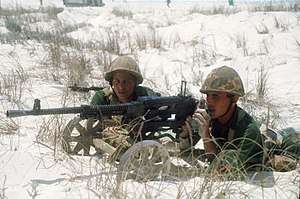SG-43 Goryunov
| SG-43 | |
|---|---|
 Egyptian marines with SG-43, 1985 | |
| Type | Medium machine gun |
| Place of origin | Soviet Union |
| Service history | |
| In service | 1943–1968 (Soviet Union) |
| Wars | World War II, Korean War, Vietnam War, Hungarian Revolution of 1956, North Yemen Civil War, Lebanese Civil War, Wars in Afghanistan, Somali Civil War, Gulf War, Burundian Civil War, Congo-Brazzaville Civil War, Iraq War, Kivu conflict, Northern Mali Conflict, Syrian Civil War |
| Production history | |
| Designer | P.M. Goryunov |
| Designed | 1940–1943[1] |
| Variants | SG-43, SGM, SGMT, SGMB |
| Specifications | |
| Weight |
13.8 kg (30.42 lb) gun body 41 kg (90.39 lb) on wheeled mount |
| Length | 1,150 mm (45.3 in) |
| Barrel length | 720 mm (28.3 in) |
|
| |
| Cartridge | 7.62×54mmR |
| Action | Gas-operated |
| Rate of fire | 500–700 rounds/min |
| Muzzle velocity | 800 m/s (2,624 ft/s) |
| Effective firing range | 1100 m (1200 yd) |
| Maximum firing range | 1,500 meters[2] |
| Feed system | 200 or 250 round belts |
| Sights | Iron sights |
The SG-43 Goryunov (Russian: Станковый пулемет системы Горюнова, Stankovyy pulemet sistemi Goryunova, meaning "Mounted machinegun, Goryunov design") was a Soviet medium machine gun that was introduced during the Second World War. It was chambered for the 7.62×54mmR cartridge, and was introduced in 1943 as a replacement for the older M1910 Maxim machine guns. It was mounted on wheeled mounts, tripods and armored vehicles.
The SG-43 used a tilting breechblock, moving sideways and locking into the side of the receiver. The feed is not straightforward, as the gun fires the 7.62×54mmR round, and this has to be withdrawn rearwards from the belt before ramming into the breech. The reciprocating motion is achieved by using two claws to pull the round from the belt, and then an arm pushes the round into the cartridge guide ready for the bolt to carry it to the breech. Despite this complication, the SG-43 was remarkably reliable and feed jams were apparently few.
The barrel is air-cooled and massively dense, contributing to a fairly high overall weight. The bore is chromium-plated and able to withstand continuous fire for long periods. The barrel can also be easily changed by releasing a simple lock, and the carrying handle allows a hot barrel to be lifted clear without difficulty. The World War II version of the gun had a smooth outline to the barrel, and the cocking handle was under the receiver, with no dust covers to the feed and ejection ports.
After the end of World War II, the SG-43 was improved and renamed SGM ("M" for modernized); dust covers and a new barrel lock were fitted, and a splined barrel was fitted to improve cooling.[3] A coaxially-mounted stockless electric solenoid-fired variant was developed under the designation SGMT (the "T" standing for Tankovy, or "Tank").
The SG-43/SGM was widely exported and also licensed for construction in several countries. It was manufactured in the People's Republic of China respectively as the Type 53 (SG-43) and Type 57 (SGMB) heavy machine guns. It was also produced in Czechoslovakia (as Vz 43) and Poland (as Wz 43).[4]
In addition to World War II, it saw service in the Korean War with the Communist North Korean and Chinese forces. In Soviet service, the Goryunov, together with the RP-46, was replaced in the 1960s by the PK machine gun due to the switch in Soviet tactical doctrine to the general-purpose machine gun concept, rendering the gun effectively obsolete.
Users













.svg.png)














See also
References
- ↑ Советская военная энциклопедия. / ред. Н.В. Огарков. том 2. М., Воениздат, 1976. стр.617
- 1 2 Edwards, Paul M. (2006). The Korean War. Westport, CT: Greenwood Press. p. 77. ISBN 0-313-33248-7.
- ↑
- ↑ Small Arms Identification and Operation Guide--Eurasian Communist Countries, Defense Intelligence Agency/United States Army Materiel Command ST-HB-07-03-74, p. 324
- ↑ Wright, Lawrence, The Looming Tower, Vintage Books (2006), ISBN 978-1-4000-3084-2, p. 134
- ↑ Small Arms Survey (2007). "Armed Violence in Burundi: Conflict and Post-Conflict Bujumbura" (PDF). The Small Arms Survey 2007: Guns and the City. Cambridge University Press. p. 204. ISBN 978-0-521-88039-8.
- ↑ https://sites.google.com/site/worldinventory/wiw_africa/https-sites-google-com-site-worldinventory-wiw_af_centralafricanrepublic
- 1 2 Gorjunov SG-43 and SGM (USSR / Russia) world.guns.ru
- ↑ Small Arms Survey (2003). "Making the Difference?: Weapon Collection and Small Arms Availability in the Republic of Congo" (PDF). Small Arms Survey 2003: Development Denied. Oxford University Press. p. 274. ISBN 0199251754.
- 1 2 Small Arms Survey (2015). "Waning Cohesion: The Rise and Fall of the FDLR–FOCA" (PDF). Small Arms Survey 2015: weapons and the world (PDF). Cambridge University Press. p. 202.
- ↑ Laffin, John (1982). Arab armies of the Middle East wars, 1948-73 (Illustrated ed.). Osprey Publishing. p. 15. ISBN 0-85045-451-4.
- ↑ Jowett, Philip (2006). Finland at War 1939-45 (Illustrated ed.). Osprey Publishing. p. 50. ISBN 1-84176-969-X.
- ↑ https://matsne.gov.ge/ka/document/view/114010
- ↑ Schmidl, Erwin; Ritter, László (10 Nov 2006). The Hungarian Revolution 1956. Elite 148. Osprey Publishing. p. 45. ISBN 9781846030796.
- ↑ Lugosi, József (2008). "Gyalogsági fegyverek 1868–2008". In Lugosi, József; Markó, György. Hazánk dicsőségére: 160 éves a Magyar Honvédség. Budapest: Zrínyi Kiadó. p. 383. ISBN 978-963-327-461-3.
- ↑ Rottman, Gordon L. (1993). Armies of the Gulf War. Elite 45. Osprey Publishing. p. 49. ISBN 9781855322776.
- ↑ Small Arms Survey (2012). "Surveying the Battlefield: Illicit Arms In Afghanistan, Iraq, and Somalia" (PDF). Small Arms Survey 2012: Moving Targets. Cambridge University Press. p. 321. ISBN 978-0-521-19714-4.
- ↑ https://sites.google.com/site/worldinventory/wiw_africa/wiw_af_libya
- ↑ Touchard, Laurent (18 June 2013). "Armée malienne : le difficile inventaire". Jeune Afrique (in French).
- ↑ Powelson, Simon J. (December 2013). "Enduring engagement yes, episodic engagement no: lessons for SOF from Mali" (PDF). Monterey, California: Naval postgraduate school. p. 24. hdl:10945/38996.
- ↑ Rottman, Gordon L. (10 Feb 2009). North Vietnamese Army Soldier 1958–75. Warrior 135. Osprey Publishing. p. 31. ISBN 9781846033711.
- ↑ http://www.nam-valka.cz/zbrane/sg-43.html
- ↑ Small Arms Survey 2012, p. 338.
- ↑ https://sites.google.com/site/worldinventory/https-sites-google-com-site-worldinventory-wiw_af_tanzania
- ↑ "WWII weapons in Yemen's civil war". wwiiafterwwii.wordpress.com. September 9, 2018.
- ↑ Headquarters 1 Brigade (Brady Barracks) (Gate Exhibit), Bulawayo, Zimbabwe: Zimbabwe National Army, 2010
External links
| Wikimedia Commons has media related to SG-43 Goryunov. |